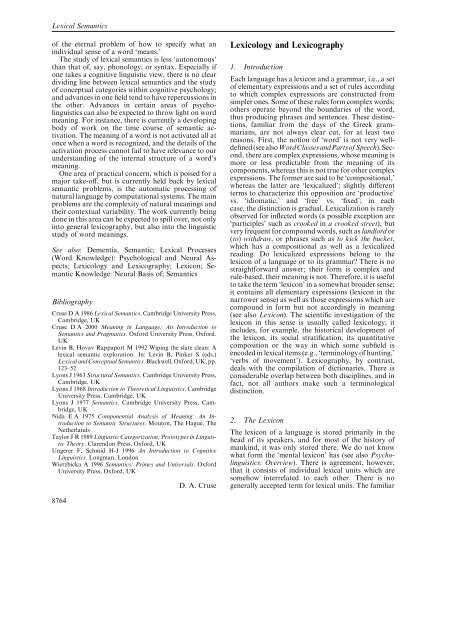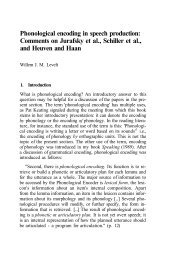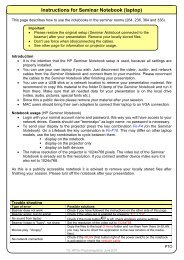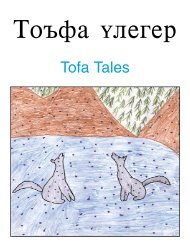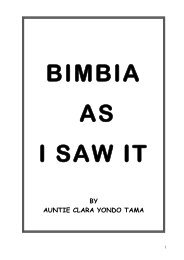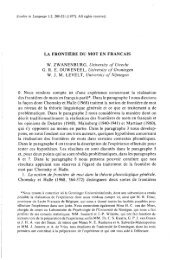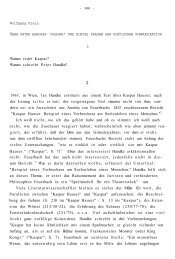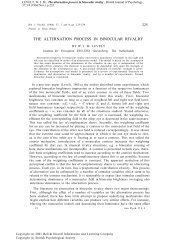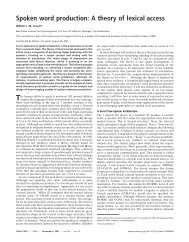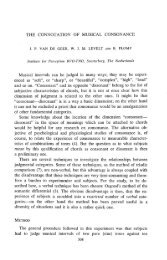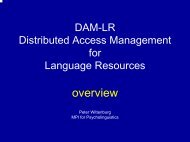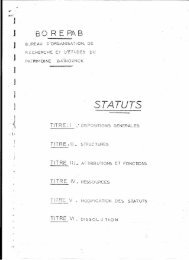Lexicology and Lexicography - PubMan
Lexicology and Lexicography - PubMan
Lexicology and Lexicography - PubMan
You also want an ePaper? Increase the reach of your titles
YUMPU automatically turns print PDFs into web optimized ePapers that Google loves.
Lexical Semantics<br />
of the eternal problem of how to specify what an<br />
individual sense of a word ‘means.’<br />
The study of lexical semantics is less ‘autonomous’<br />
than that of, say, phonology, or syntax. Especially if<br />
one takes a cognitive linguistic view, there is no clear<br />
dividing line between lexical semantics <strong>and</strong> the study<br />
of conceptual categories within cognitive psychology;<br />
<strong>and</strong> advances in one field tend to have repercussions in<br />
the other. Advances in certain areas of psycholinguistics<br />
can also be expected to throw light on word<br />
meaning. For instance, there is currently a developing<br />
body of work on the time course of semantic activation.<br />
The meaning of a word is not activated all at<br />
once when a word is recognized, <strong>and</strong> the details of the<br />
activation process cannot fail to have relevance to our<br />
underst<strong>and</strong>ing of the internal structure of a word’s<br />
meaning.<br />
One area of practical concern, which is poised for a<br />
major take-off, but is currently held back by lexical<br />
semantic problems, is the automatic processing of<br />
natural language by computational systems. The main<br />
problems are the complexity of natural meanings <strong>and</strong><br />
their contextual variability. The work currently being<br />
done in this area can be expected to spill over, not only<br />
into general lexicography, but also into the linguistic<br />
study of word meanings.<br />
See also: Dementia, Semantic; Lexical Processes<br />
(Word Knowledge): Psychological <strong>and</strong> Neural Aspects;<br />
<strong>Lexicology</strong> <strong>and</strong> <strong>Lexicography</strong>; Lexicon; Semantic<br />
Knowledge: Neural Basis of; Semantics<br />
Bibliography<br />
Cruse D A 1986 Lexical Semantics. Cambridge University Press,<br />
Cambridge, UK<br />
Cruse D A 2000 Meaning in Language: An Introduction to<br />
Semantics <strong>and</strong> Pragmatics. Oxford University Press, Oxford.<br />
UK<br />
Levin B, Hovav Rappaport M 1992 Wiping the slate clean: A<br />
lexical semantic exploration. In: Levin B, Pinker S (eds.)<br />
Lexical <strong>and</strong> Conceptual Semantics. Blackwell, Oxford, UK, pp.<br />
123–52<br />
Lyons J 1963 Structural Semantics. Cambridge University Press,<br />
Cambridge, UK<br />
Lyons J 1968 Introduction to Theoretical Linguistics. Cambridge<br />
University Press, Cambridge, UK<br />
Lyons J 1977 Semantics. Cambridge University Press, Cambridge,<br />
UK<br />
Nida E A 1975 Componential Analysis of Meaning: An Introduction<br />
to Semantic Structures. Mouton, The Hague, The<br />
Netherl<strong>and</strong>s<br />
Taylor J R 1989 Linguistic Categorization: Prototypes in Linguistic<br />
Theory. Clarendon Press, Oxford, UK<br />
Ungerer F, Schmid H-J 1996 An Introduction to Cognitie<br />
Linguistics. Longman, London<br />
Wierzbicka A 1996 Semantics: Primes <strong>and</strong> Uniersals. Oxford<br />
University Press, Oxford, UK<br />
D. A. Cruse<br />
<strong>Lexicology</strong> <strong>and</strong> <strong>Lexicography</strong><br />
1. Introduction<br />
Each language has a lexicon <strong>and</strong> a grammar, i.e., a set<br />
of elementary expressions <strong>and</strong> a set of rules according<br />
to which complex expressions are constructed from<br />
simpler ones. Some of these rules form complex words;<br />
others operate beyond the boundaries of the word,<br />
thus producing phrases <strong>and</strong> sentences. These distinctions,<br />
familiar from the days of the Greek grammarians,<br />
are not always clear cut, for at least two<br />
reasons. First, the notion of ‘word’ is not very welldefined(seealsoWordClasses<strong>and</strong>PartsofSpeech).Second,<br />
there are complex expressions, whose meaning is<br />
more or less predictable from the meaning of its<br />
components, whereas this is not true for other complex<br />
expressions. The former are said to be ‘compositional,’<br />
whereas the latter are ‘lexicalized’; slightly different<br />
terms to characterize this opposition are ‘productive’<br />
vs. ‘idiomatic,’ <strong>and</strong> ‘free’ vs. ‘fixed’; in each<br />
case, the distinction is gradual. Lexicalization is rarely<br />
observed for inflected words (a possible exception are<br />
‘participles’ such as crooked in a crooked street), but<br />
very frequent for compound words, such as l<strong>and</strong>lord or<br />
(to) withdraw, or phrases such as to kick the bucket,<br />
which has a compositional as well as a lexicalized<br />
reading. Do lexicalized expressions belong to the<br />
lexicon of a language or to its grammar There is no<br />
straightforward answer; their form is complex <strong>and</strong><br />
rule-based, their meaning is not. Therefore, it is useful<br />
to take the term ‘lexicon’ in a somewhat broader sense;<br />
it contains all elementary expressions (lexicon in the<br />
narrower sense) as well as those expressions which are<br />
compound in form but not accordingly in meaning<br />
(see also Lexicon). The scientific investigation of the<br />
lexicon in this sense is usually called lexicology; it<br />
includes, for example, the historical development of<br />
the lexicon, its social stratification, its quantitative<br />
composition or the way in which some subfield is<br />
encoded in lexical items (e.g., ‘terminology of hunting,’<br />
‘verbs of movement’). <strong>Lexicography</strong>, by contrast,<br />
deals with the compilation of dictionaries. There is<br />
considerable overlap between both disciplines, <strong>and</strong> in<br />
fact, not all authors make such a terminological<br />
distinction.<br />
2. The Lexicon<br />
The lexicon of a language is stored primarily in the<br />
head of its speakers, <strong>and</strong> for most of the history of<br />
mankind, it was only stored there. We do not know<br />
what form the ‘mental lexicon’ has (see also Psycholinguistics:<br />
Oeriew). There is agreement, however,<br />
that it consists of individual lexical units which are<br />
somehow interrelated to each other. There is no<br />
generally accepted term for lexical units. The familiar<br />
8764
<strong>Lexicology</strong> <strong>and</strong> <strong>Lexicography</strong><br />
term ‘word’ is both too broad <strong>and</strong> too narrow; one<br />
would not want to consider goes as a lexical unit,<br />
although it is a word, whereas expressions such as (to)<br />
cut up or red herring are lexical units but consist of<br />
several words. Other terms occasionally found are<br />
‘lexeme,’ ‘lemma,’ or ‘lexical entry,’ but since these are<br />
also used in other ways, it is probably best to speak of<br />
lexical units.<br />
It is important to distinguish between a lexical unit<br />
<strong>and</strong> the way in which it is named. The word house in a<br />
dictionary, followed by all sorts of explanations, is not<br />
the lexical unit—it is a name for such a unit. The<br />
lexical unit itself is a bundle of various types of<br />
properties. These include:<br />
(a) phonological properties, which characterize how<br />
the lexical unit is pronounced; they include sounds,<br />
syllabic structure, lexical accent <strong>and</strong>, in some<br />
languages, lexical tone;<br />
(b) graphematic properties, which characterize how<br />
the lexical unit is written (see also Spelling);<br />
(c) morphosyntactic properties, which characterize<br />
how the unit can become part of more complex<br />
expressions; typically, they concern inflectional paradigm,<br />
word class, government relations, <strong>and</strong> others;<br />
(d) semantic properties, which concern the ‘lexical<br />
meaning’ of the unit, i.e., the contribution which it<br />
makes to the meaning of the construction in which it<br />
occurs.<br />
Some of these properties may be absent. This is<br />
most obvious for graphematic properties, since not all<br />
languages are written. There are a few lexical units<br />
without lexical meaning, such as the expletive there in<br />
English. Many linguists also stipulate ‘zero elements,’<br />
i.e., units with morphosyntactic <strong>and</strong> semantic properties<br />
but without phonological properties (such as<br />
‘empty pronouns’); but these are normally treated in<br />
the grammar rather than in the lexicon.<br />
Whereas these four types of properties are the<br />
defining characteristics of a lexical unit, other information<br />
may be associated with it, for example, its<br />
etymology, its frequency of usage, its semantic<br />
counterpart in other languages, or encyclopedic<br />
knowledge (thus, it is one thing to know the meaning<br />
of bread <strong>and</strong> a different thing to know various sorts of<br />
bread, how it is made, its price, its role in the history of<br />
mankind, etc.).<br />
The lexical units of a lexicon are in many ways<br />
interrelated. They may share some phonological properties<br />
(for example, they may rhyme with each other),<br />
they may belong to the same inflectional paradigm,<br />
they may have the opposite meaning (‘antonyms,’<br />
such as black <strong>and</strong> white), approximately the same<br />
meaning (‘synonyms,’ such as to begin <strong>and</strong> to start), or<br />
when complex in form they may follow the same<br />
construction pattern. Lexicological research is often<br />
oriented towards these interrelations, whereas lexicography<br />
tends to give more weight to the lexical unit<br />
in itself. In general, there is much more lexicographical<br />
than lexicological work (for a survey of the latter, see<br />
Schwarze <strong>and</strong> Wunderlich 1985); in fact, if there is any<br />
piece of linguistic description for some language, it is<br />
probably an elementary bilingual dictionary. The<br />
depth of this work varies massively not only across<br />
languages, but also with respect to the particular<br />
lexical properties. Whereas the phonological, graphematic<br />
<strong>and</strong> morphosyntactic features of the lexicon in<br />
Latin, English, French, <strong>and</strong> some dozen other<br />
languages with a comparable research tradition are<br />
fairly well described, there is no theoretically <strong>and</strong><br />
empirically satisfactory analysis of the semantics of<br />
the lexicon for any language whatsoever. This has<br />
three interrelated reasons. First, there is no welldefined<br />
descriptive language which would allow the<br />
researcher to represent the meaning of some lexical<br />
unit, be it simple or compound; the most common<br />
practice is still to paraphrase it by an expression of the<br />
same language. Second, there is no reliable <strong>and</strong> easily<br />
applicable method of determining the lexical meaning<br />
of some unit; the most common way is to look at a<br />
number of occurrences in ongoing text <strong>and</strong> to try to<br />
underst<strong>and</strong> what it means. Third, the relation between<br />
a particular form <strong>and</strong> a particular meaning is hardly<br />
ever straightforward; this is strikingly illustrated by a<br />
look at what even a medium-sized English dictionary<br />
has to say about the meaning of, for example, on,<br />
sound, eye or (to) put up. As a rule, there is not just one<br />
lexical meaning, but a whole array of uses which are<br />
more or less related to each other. This is not merely a<br />
practical problem for the lexicographer; it also casts<br />
some doubt on the very notion of ‘lexical unit’ itself<br />
(see also Lexical Semantics).<br />
3. Making Dictionaries<br />
Lexicographers often consider their work to be more<br />
of an art or a craft than a science (see, e.g., L<strong>and</strong>au<br />
1984, Svense n 1993). This does not preclude a solid<br />
scientific basis, but it reflects the fact that their concrete<br />
work depends largely on practical skills such as being<br />
‘a good definer,’ on one h<strong>and</strong>; <strong>and</strong> that it is to a great<br />
extent determined by practical, often commercial,<br />
concerns, on the other. Dictionaries are made for<br />
users, <strong>and</strong> they are intended to serve specific purposes.<br />
Their compilation requires a number of practical<br />
decisions.<br />
3.1 Which Lexical Units are Included<br />
Languages are neither well-defined nor uniform entities;<br />
they change over time, <strong>and</strong> they vary with factors<br />
such as place, social class, or area talked about. A<br />
great deal of this variation is lexical. It is not possible<br />
nor would it be reasonable to cover this wealth in a<br />
single dictionary. Large dictionaries contain up to<br />
300,000 ‘entries’; since idiomatic expressions are<br />
usually listed under one of their components (such as<br />
8765
<strong>Lexicology</strong> <strong>and</strong> <strong>Lexicography</strong><br />
to kick the bucket under (to) kick), they contain many<br />
more lexical units, perhaps up to 1 million. But, even<br />
so, they are by no means exhaustive. The second<br />
edition of the Deutsches Wo rterbuch (see Sect. 5), the<br />
largest dictionary of German, covers less than 25 per<br />
cent of the lexical units found in the sources, <strong>and</strong> these<br />
sources are quite restricted themselves.<br />
3.2 Which Lexical Properties are Described<br />
Just as it is impossible to include all lexical units of a<br />
language in a dictionary, it is neither possible nor<br />
desirable to aim at a full description of those which are<br />
included. Since a dictionary is normally a printed<br />
book, the graphematic properties of the unit (its<br />
‘spelling’) are automatically given. Among the other<br />
defining properties, meaning is traditionally considered<br />
to be most important. Samuel Johnson’s<br />
dictionary from 1755 (see Sect. 5) defines ‘dictionary’<br />
as ‘A book containing the words of any language in<br />
alphabetical order, with explanations of their meaning.’<br />
But Johnson also noted which syllable carries the<br />
main stress, <strong>and</strong> he gave some grammatical hints. In<br />
general, however, information on phonological properties<br />
was rare up to the end of the nineteenth century,<br />
<strong>and</strong> information on grammatical properties is usually<br />
still very restricted in nonspecialized dictionaries. But<br />
there are, of course, also dictionaries which specifically<br />
address these properties as well as some of the<br />
nondefining properties associated with a lexical entry,<br />
such as its origin (etymological dictionary) or, above<br />
all, its equivalent in other languages (‘bilingual dictionary’).<br />
3.3 What is the Description Based Upon<br />
Usually, two types of sources are distinguished:<br />
‘primary sources’ are samples of text in which the unit<br />
is used, ‘secondary sources’ refers to prior work of<br />
other lexicographers (<strong>and</strong> lexicologists). In fact, there<br />
is a third source, normally not mentioned in the<br />
theory of lexicography (sometimes called ‘meta-lexicography’):<br />
this is the lexicographer’s own knowledge of<br />
the language to be described, including his or her views<br />
on what is ‘good’ language. In practice, the bulk of a<br />
new dictionary is based on older dictionaries. This is<br />
always immoral <strong>and</strong> often illegal, if these are simply<br />
copied; but on the other h<strong>and</strong>, it would be stupid <strong>and</strong><br />
arrogant to ignore the achievements of earlier lexicographers.<br />
3.4 How is the Information Presented<br />
A dictionary consists of lexical entries arranged in<br />
some conventional order. Normally, an entry combines<br />
several lexical units under a single ‘head word’;<br />
thus, all lexical units which include the word put may<br />
be listed under this head word, forming a kind of nest<br />
with an often very complex microstructure. We are<br />
used to alphabetically-ordered dictionaries; but there<br />
are other possibilities, for example, by thematic groups<br />
or by first appearance in written documents.<br />
Languages without alphabetic writing require different<br />
principles; in Chinese, for example, entries are usually<br />
arranged by subcomponents of the entire character<br />
<strong>and</strong> by the number of strokes.<br />
These four questions can be answered in very<br />
different ways, resulting in very different types of<br />
dictionaries (see the survey in Hausmann et al. 1991,<br />
pp. 968–1573).<br />
4. History<br />
The first lexicographic documents are lists of Sumerian<br />
words (up to 1400) with their Akkadian equivalents,<br />
written in cuneiform script on clay tablets about 4,700<br />
years ago. The practice compiling such word lists was<br />
continued throughout Antiquity <strong>and</strong> the Middle Ages;<br />
thus, the oldest document in German, the Abrogans<br />
(written around 765), is an inventory of some Latin<br />
words with explanations in German. Usually, these<br />
‘glossaries’ did not aim at a full account of the lexicon;<br />
they simply brought together a number of words<br />
which, for one reason or another, were felt to be<br />
‘difficult,’ <strong>and</strong> explained them either by a more familiar<br />
word in the same language or by a translation. Words<br />
were ordered alphabetically, by theme, or not at all.<br />
But there are also more systematic attempts, such as<br />
the Catholicon, a mixture of encyclopedia <strong>and</strong> dictionary<br />
which, compiled around 1250, was the first<br />
printed lexical work in Europe (Mainz 1460).<br />
In the sixteenth century, two developments led to<br />
major changes. The first of these was the invention of<br />
printing by Gutenberg. By 1500, virtually all classical<br />
authors were available in print, thus offering a solid<br />
basis for systematic lexical accounts of Latin <strong>and</strong><br />
Greek, such as Calepinus’ Dictionarium (1502), soon<br />
to be followed by two early masterpieces: Robert<br />
Etienne’s Dictionarium seu Latinae Linguae Thesaurus<br />
(Paris 1531) <strong>and</strong> Henri Etienne’s Thesaurus Graecae<br />
Linguae (Paris 1572). The second major development<br />
was the slow but steady rise of national languages.<br />
Since early Italian, French, English, or German were<br />
hardly codified, a major aim of the first dictionaries in<br />
these languages was to give them clear norms. In some<br />
countries, national Academies were founded to this<br />
end. The outcome were dictionaries with a strongly<br />
normative, often puristic, stance, such as the<br />
Vocabulario degli Academici della Crusca (Venice<br />
1612), the Dictionnaire de l’Acade mie Franc aise (Paris<br />
1694) <strong>and</strong> the Diccionario de autoridades publicado por<br />
la Real Academia Espanola (1726–1739).<br />
The bulk of lexicographic work, however, was<br />
always done by enterprising publishers <strong>and</strong> engaged<br />
8766
<strong>Lexicology</strong> <strong>and</strong> <strong>Lexicography</strong><br />
individuals, such as Dr Samuel Johnson. Helped by six<br />
assistants, he produced A Dictionary of the English<br />
Language (London 1755), the first scholarly description<br />
of the English vocabulary, in less than eight years.<br />
It surpassed all its predecessors, including Bailey’s<br />
Dictionarium Britannicum from 1736, which Johnson<br />
took as his point of departure, by the systematic use of<br />
quotations, taken from the best writers, <strong>and</strong> by his<br />
brilliant, sometimes somewhat extravagant, definitions<br />
(not everybody would dare to characterize<br />
patriotism as ‘the last refuge of a scoundrel’). Less<br />
known, much less witty, but broader in coverage is the<br />
first comprehensive dictionary of German, Johann<br />
Christoph Adelungs Versuch eines ollsta ndigen grammatisch-kritischen<br />
Wo rterbuchs der hochdeutschen<br />
Mundart (Leipzig 1774–86).<br />
The rise of historical-comparative linguistics in the<br />
early nineteenth century led to an enormous increase<br />
in grammatical <strong>and</strong> lexical knowledge. The first<br />
dictionary which tried to cover this knowledge was<br />
the Deutsches Wo rterbuch by Jacob Grimm <strong>and</strong> (to a<br />
much lesser extent) his brother Wilhelm Grimm. Its<br />
first fascicle appeared in 1852, after about ten years of<br />
preparatory work, in which the Grimms were helped<br />
by about 100 scholars providing excerpts (‘covering<br />
my desk like snowflakes,’ Jacob Grimm). At that time,<br />
it was already clear that the original plan of 6–7<br />
volumes, to be finished within 10–12 years, was unrealistic.<br />
The Grimms finished only letters A–(most<br />
of) F, <strong>and</strong> the final folio volume (of altogether 32)<br />
appeared in 1960. This long duration, as well as the<br />
varying talents <strong>and</strong> preferences of the contributors,<br />
has led to many inconsistencies; some entries got out<br />
of balance (no less than 60 pages are devoted to the<br />
single word Geist); still, it is an incommensurable<br />
source of lexical information.<br />
The work of the Grimms inspired a number of<br />
similar ventures, such as Emile Littre ’s masterly<br />
Dictionnaire de la langue franc aise (1863–1873), which<br />
is much shorter, but also much more consistent:<br />
Matthias de Vries <strong>and</strong> his numerous successors’<br />
voluminous Woordenboek der Nederl<strong>and</strong>sche Taal<br />
(1864–1998), <strong>and</strong> finally A New English Dictionary on<br />
a Historical Basis (1884–1928), generally referred to as<br />
the ‘Oxford English Dictionary’ (OED). It was<br />
initiated in 1857 by the philologist <strong>and</strong> churchman<br />
Richard Trench; in 1860, members of the Philological<br />
Society started to collect excerpts; in 1879, the Clarendon<br />
Press appointed James Murray as the Principal<br />
Editor. The first fascicle appeared in 1882, <strong>and</strong> the<br />
whole work was completed in 1928, 13 years<br />
after Murray’s death. More than 200 scholars were<br />
involved in its production, more than 2,000 people are<br />
known to have contributed excerpts. The OED is not<br />
without flaws, even in its revised edition, which<br />
appeared in 1989 in print <strong>and</strong> in 1992 on CD-ROM;<br />
but among all attempts to describe the lexicon of a<br />
language, it comes closest to falsify what Dr Johnson<br />
stated in the preface to his own dictionary: ‘Every<br />
other author may aspire to praise; the lexicographer<br />
can only hope to escape reproach.’ (For a comprehensive<br />
survey of lexicographic work across languages,<br />
see Hausmann et al. 1991, pp. 1679–2710,<br />
2949–3119).<br />
5. The Use of Computers<br />
We tend to think of dictionaries as the normal, if not<br />
the only possible way to compile <strong>and</strong> to present lexical<br />
information. But the dawn of the computer has<br />
provided us with a very different <strong>and</strong> in many ways<br />
more efficient tool. Computers can be used in at least<br />
three ways in lexicography. It is possible to transfer an<br />
existing dictionary to a computer, as has often been<br />
done over the last 20 years. Such a transfer offers<br />
several advantages: search is faster <strong>and</strong> more exhaustive;<br />
it is easier to revise <strong>and</strong> update the dictionary; <strong>and</strong><br />
it is possible to add information not available in book<br />
format, for example, spoken sound instead of phonetic<br />
transcriptions. But essentially, the format of the<br />
printed book is maintained. Next, computers are a<br />
powerful tool in the production of a new dictionary.<br />
Rather than having a number of people read through<br />
books <strong>and</strong> newspapers <strong>and</strong> make excerpts of all<br />
occurrences which look interesting, it is now possible<br />
to compile huge text corpora that cover all varieties of<br />
a language, to scan these texts for all occurrences of<br />
words or word combinations, to sort these occurrences<br />
by various criteria, to link them to other occurrences,<br />
to add as much context as needed, etc. (see Corpus<br />
Linguistics).<br />
The OED, is based on about 5 million excerpts,<br />
mostly h<strong>and</strong>written on paper slips. A computer can<br />
easily process corpora of several hundred million<br />
words, i.e., several hundred million occurrences; new<br />
sources can rapidly be added. This allows a much<br />
broader <strong>and</strong> much more representative coverage of a<br />
lexicon than ever. But electronic corpora only provide<br />
the raw material; it still awaits lexical analysis. This<br />
analysis can be facilitated by computer tools, also; but<br />
no computer can tell us what a word means in a<br />
particular context. But even if only one minute is<br />
devoted to each occurrence in a one-hundred million<br />
corpus, it would take 10 lexicographers 100 years to go<br />
through it. This means that printed dictionaries can<br />
never reflect the wealth of information accessible in<br />
large corpora, since they presuppose that the lexicographer<br />
has finished the analysis. Therefore, the<br />
only way to make full use of large corpora is by means<br />
of lexical retrieval systems. They consist of (a) a<br />
computer-accessible <strong>and</strong> exp<strong>and</strong>able corpus, (b) a set<br />
of tools, which allow, for example, not only the search<br />
for certain items but also statistical analysis or the<br />
determination of the first occurrence, <strong>and</strong> (c) a<br />
selective but steadily proceeding lexical analysis of the<br />
corpus. Thus, it is possible to add spoken forms in<br />
various dialects, information about word classes, or<br />
8767
<strong>Lexicology</strong> <strong>and</strong> <strong>Lexicography</strong><br />
the semantic analysis of some subset of lexical units,<br />
say all prepositions or all morphologically simple<br />
verbs. Similarly, translation equivalents can be added.<br />
Unlike printed dictionaries, such a lexical retrieval<br />
system will never come to an end, it is steady work-inprogress<br />
to which many can contribute <strong>and</strong> which will<br />
give us a deeper <strong>and</strong> broader underst<strong>and</strong>ing of the<br />
lexicon than any other method.<br />
See also:; Corpus Linguistics; Lexical Access, Cognitive<br />
Psychology of; Lexical Processes (Word Knowledge):<br />
Psychological <strong>and</strong> Neural Aspects; Lexical<br />
Semantics<br />
Bibliography<br />
Hausmann F-J, Reichmann O, Wieg<strong>and</strong> H E, Zgusta L (eds.)<br />
1991 Wo rterbu cher—Dictionaries—Dictionnaires. De Gruyter,<br />
Berlin<br />
L<strong>and</strong>au S A 1984 Dictionaries: The Art <strong>and</strong> Craft of <strong>Lexicography</strong>.<br />
Scribner, New York<br />
McArthur T 1986 Worlds of Reference. <strong>Lexicography</strong>, Learning<br />
<strong>and</strong> Language from the Clay Tablet to the Computer. Cambridge<br />
University Press, Cambridge, UK<br />
Schwarze C, Wunderlich D (eds.) 1985 H<strong>and</strong>buch der Lexikologie.<br />
Athena um, Ko nigstein, Germany<br />
Svense n B 1993 Practical Lexikography. Principles <strong>and</strong> Methods<br />
of Dictionary Making. Oxford University Press, Oxford, UK<br />
Lexicon<br />
1. The Notion of Lexicon<br />
W. Klein<br />
The lexicon is st<strong>and</strong>ardly viewed as a listing of all the<br />
morphemes of a language, with information indicating<br />
how each morpheme behaves in the components of<br />
grammar involving phonology, syntax, <strong>and</strong> semantics.<br />
In no small part, the shape <strong>and</strong> character of grammar<br />
is determined by what the lexicon contains for these<br />
other grammatical devices. Nevertheless, both historically<br />
<strong>and</strong> conventionally, the lexicon has been seen<br />
as the passive module in the system of grammar.<br />
More recently, the model of the lexicon has undergone<br />
significant revision <strong>and</strong> maturation. In particular,<br />
two trends have driven the architectural concerns<br />
of lexical researchers: (a) a tighter integration of<br />
compositional operations of syntax <strong>and</strong> semantics<br />
with the lexical information structures that bear them;<br />
<strong>and</strong> (b) a serious concern with how lexical types reflect<br />
the underlying ontological commitments of the grammar.<br />
In the process, the field has moved towards<br />
addressing more encompassing problems in linguistic<br />
theory, such as those below:<br />
(a) How can we explain the polymorphic nature of<br />
language<br />
(b) How can we capture the creative use of words in<br />
novel contexts<br />
(c) How can semantic types predictably map to<br />
syntactic representations<br />
(d) What are the ‘atoms’ of lexical knowledge, if<br />
they exist at all<br />
In this article, we first review the conventional view<br />
of the lexicon <strong>and</strong> then contrast this with the theories<br />
of lexical information that have emerged since around<br />
1990.<br />
By all accounts, the conventional model of the<br />
lexicon is that of a database of words, ready to act in<br />
the service of more dynamic components of the<br />
grammar. This view has its origins squarely in the<br />
generative tradition (Chomsky 1955) <strong>and</strong> has been an<br />
increasingly integral part of the concept of the lexicon<br />
ever since. While the ‘Aspects’ model of selectional<br />
features restricted the relation of selection to that<br />
between lexical items, work by Jackendoff (1972) <strong>and</strong><br />
McCawley (1968), showed that selectional restrictions<br />
must be available to computations at the level of<br />
derived semantic representation rather than at deep<br />
structure. But where did this view come from In order<br />
to underst<strong>and</strong> both the classical model of the lexicon<br />
as a database <strong>and</strong> the current models of lexically<br />
encoded grammatical information, it is necessary to<br />
appreciate the structuralist distinction between ‘syntagmatic<br />
processes’ <strong>and</strong> ‘paradigmatic systems’ in<br />
language. The lexicon has emerged as the focal point<br />
communicating between these two components, <strong>and</strong><br />
can be seen as a hook which links the information at<br />
these two levels. One can go further still <strong>and</strong> view the<br />
elements of the lexicon as not just the building blocks<br />
for the more active components of the grammar, but<br />
also as actively engaging the building principles<br />
themselves.<br />
While syntagmatic processes refer to the influence of<br />
horizontal elements on a word or phrase, paradigmatic<br />
systems refer to vertical substitutions in a phrasal<br />
structure. Syntagmatics evolved into the theory of<br />
abstract syntax while paradigmatics was all but ab<strong>and</strong>oned<br />
in generative linguistics. In an early discussion<br />
of syntagmatic dependencies, Hjelmslev (1943) uses<br />
the term ‘selection’ explicitly in the modern sense <strong>and</strong><br />
notes the importance of integrating paradigmatic<br />
systems with the syntagmatic processes they participate<br />
in. For Hjelmslev, there are two possible types of<br />
relations that can exist between elements in a syntagmatic<br />
process: ‘interdependence’ <strong>and</strong> ‘determination’,<br />
the latter of which is related to the notion of<br />
selectional restriction as developed by Chomsky<br />
(1965). As Cruse (1986) notes ‘One reason that<br />
selectional restrictions were not integrated into mechanisms<br />
of grammatical selection <strong>and</strong> description in the<br />
1970s <strong>and</strong> 1980s is that, if they are imposed correctly,<br />
the grammar is forced to model two computations:<br />
(a) the entailment relations between selectional<br />
8768<br />
Copyright 2001 Elsevier Science Ltd. All rights reserved.<br />
International Encyclopedia of the Social & Behavioral Sciences ISBN: 0-08-043076-7


